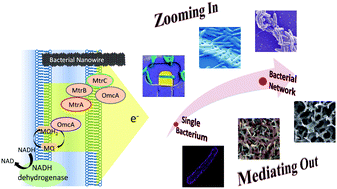Nanostructured interfaces for probing and facilitating extracellular electron transfer
Abstract
Extracellular electron transfer (EET) is a process performed by electrochemically active bacteria (EAB) to transport metabolically-generated electrons to external solid-phase acceptors through specific molecular pathways. Naturally bridging biotic and abiotic charge transport systems, EET offers ample opportunities in a wide range of bio-interfacing applications, from renewable energy conversion, resource recovery, to bioelectronics. Full exploration of EET fundamentals and applications demands technologies that could seamlessly interface and interrogate with key components and processes at relevant length scales. In this review, we will discuss the recent development of nanoscale platforms that enabled EET investigation from single-cell to network levels. We will further overview research strategies for utilizing rationally designed and integrated nanomaterials for EET facilitation and efficiency enhancement. In the future, EET components such as c-cytochrome based outer membranes and bacterial nanowires along with their assembled structures will present themselves as a whole new category of biosynthetic electroactive materials with genetically encoded functionality and intrinsic biocompatibility, opening up possibilities to revolutionize the way electronic devices communicate with biological systems.

- This article is part of the themed collections: Recent Review Articles and Journal of Materials Chemistry B Emerging Investigators


 Please wait while we load your content...
Please wait while we load your content...
